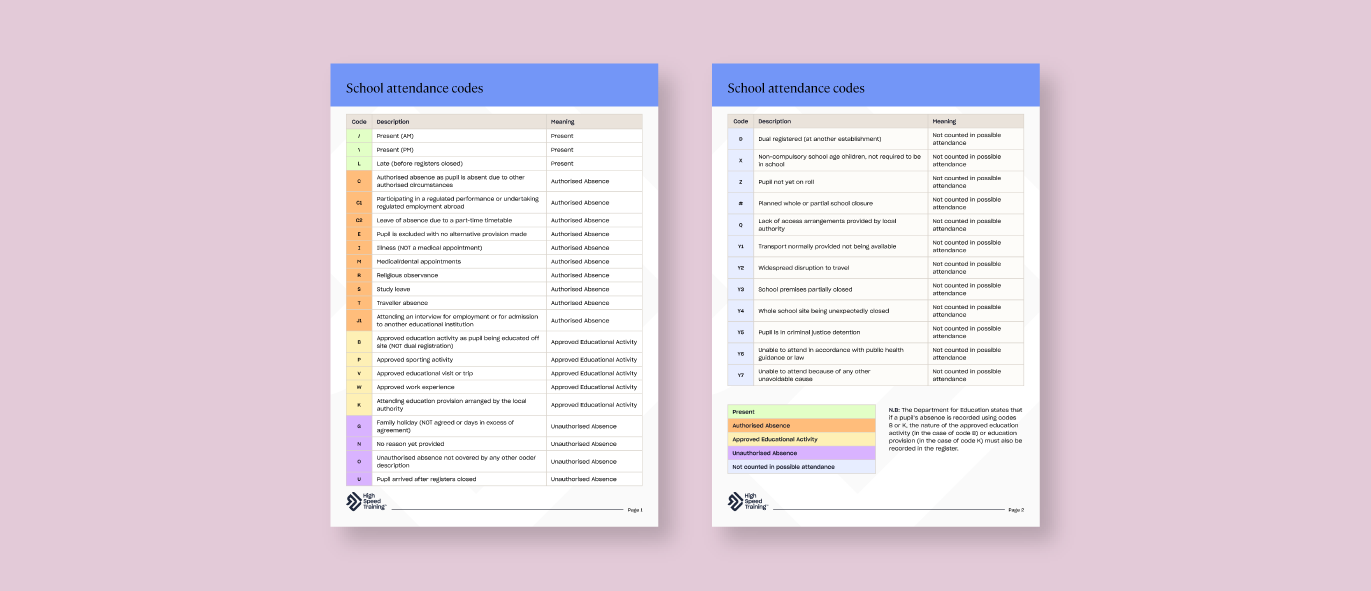Attendance Codes: A Guide for Schools
Consistent school attendance is an integral part of a child receiving the best education possible. Parents, guardians and carers have a legal responsibility to ensure that their child receives an education, whether that be by attending a school or home schooling. For children who attend a school, their parents, guardians and carers have the additional legal obligation to ensure that they attend regularly.
For teachers and those working in a school environment, monitoring a child’s attendance is an important part of identifying students who may require additional support. As well as this, attendance registers play a key role in safeguarding children as they monitor a child’s location and can be used to ensure that a child is where they are supposed to be. In this article we will discuss attendance codes and how they are used in schools. We will also provide you with a free downloadable resource that details the different codes used and their meaning.
What are School Attendance Codes?
School attendance codes are codes used to track and record a child’s attendance or absence. The codes have different meanings and can represent attendance, authorised absence or unauthorised absence. All schools, except boarding schools, must keep an attendance register in accordance with the School Attendance (Pupil Registration) (England) Regulations 2024.
These registers utilise different codes to ensure consistent monitoring and recording of attendance. Attendance codes are an important part of collecting statistics that schools, local authorities and the government can use to gain a better understanding of the education being provided and the levels of, and reasons for, absence.

Children may be absent from school for a number of different reasons. As such, the new codes seek to offer more precision in recording a student’s absence. This ensures that taking attendance registers doesn’t take longer than needed, whilst still including the necessary information to accurately monitor attendance and absence.
It’s worth noting that due to the expansion of school attendance codes it should only be necessary to use one code at a time when marking a child’s attendance or absence. For example, if a child was present for morning registration but arrived after the register had started, but not before it had closed, the appropriate code would be ‘L’ not ‘/ L.’ Some attendance codes have more than one character, however this doesn’t necessarily denote two separate codes being used in conjunction. Attendance codes and their meanings will be explored later in this article.
Attendance Guidelines for Schools
As mentioned above, consistent school attendance is a vital part of a child’s education and there have been numerous studies on the negative impact of a child missing school. There are many different reasons why a child may miss school ranging from infrequent illness to refusal to attend due to mental health issues or bullying. Regardless of the reason, it’s important to understand why a child is missing their education.
The new school attendance regulations and the codes that it introduces strengthens measures for addressing persistent and severe absence. The new codes enable schools to engage with early interventions and collaborate with local authorities and families to resolve issues before they escalate. Guidance from the Department for Education encourages schools to regularly analyse attendance and absence data to identify pupils or cohorts that require support with their attendance. Schools can then use this data to put effective strategies in place to support pupils to consistently attend school.
The new codes help to make regular data analysis easier and enable schools and multi-academy trusts (MATs) to provide better tailored attendance support to individual pupils. This facilitates a more holistic approach in which parents, guardians and carers and external partners such as health services and local authorities, can come together to support students where necessary.
Want to Learn More?
We have a wide range of CPD Courses for Teaching and Education that can bolster your knowledge, ensuring you are providing the best support possible for your students. Courses such as our Challenging Behaviour and Child Mental Health can provide you with the understanding to confidently support pupils in various situations.
Attendance Codes and Meanings
School registers must be taken twice a day and the appropriate code used to indicate a child’s absence or attendance at school. Below you will find a free, downloadable table that details the different attendance codes that should be used during registration and their respective meaning. We would advise prominently displaying this table so that each time you take the register you can quickly refer to it should you need and input the appropriate code.
It’s worth noting that not all codes are new and adjustments have been made to existing codes to better reflect variations in meaning. For example, code ‘I’ still indicates illness, however there are now more stringent reporting protocols for when a pupil is absent from illness for an extended period.

Attendance codes are an important part of monitoring attendance and absence. They provide valuable information which schools and local authorities can use to better support students and address recurrent absences. Consistent school attendance is a vital part of a child receiving the best education possible. Accurate monitoring of attendance and absence is therefore essential to support and facilitate consistent school attendance.
Further Resources:
- What is the Importance of School Attendance?
- Understanding Children Missing Education (CME)
- Working Together to Safeguard Children: Key Points and Changes
- CPD Courses for Teaching and Education











